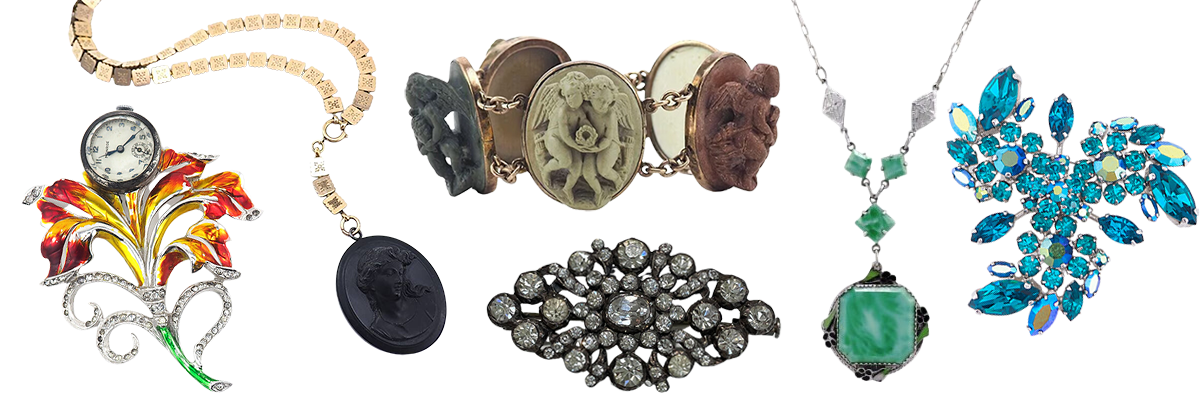A Timeline of the Important Eras in Jewelry History

A Brief Timeline of the Important Eras in Jewelry History
These eras in jewelry history each had distinct characteristics and were influenced by the social, artistic, and technological trends of their times. They continue to influence jewelry design today.
1. Georgian Era (1714-1837):
- The Georgian era spans the reigns of the four King Georges in Britain.
- Jewelry from this period is characterized by elaborate designs featuring intricate metalwork, gemstones, and natural motifs such as flowers, leaves, and animals.
- Diamonds, pearls, and colored gemstones like emeralds and rubies were commonly used.
2. Regency Era (1811-1830):
- The Regency era overlaps with the later part of the Georgian era.
- Jewelry during this time was influenced by the Neoclassical style, featuring Greco-Roman motifs like cameos and Greek key patterns.
- Filigree work, delicate settings, and minimalism were prevalent.
3. Industrial Era (c. 1860-1900):
- The Industrial era saw advancements in jewelry production methods, including machine manufacturing.
- Mass-produced jewelry became more affordable and accessible.
- Jewelry designs incorporated geometric shapes and materials like steel and aluminum.
The Victorian era can be divided into several sub-eras:
- Romantic (1837-1860): Known for sentimental jewelry with motifs like hearts, flowers, and lockets.
- Grand (1861-1880):Featured opulent, elaborate designs with large gemstones and intricate metalwork.
- Aesthetic (1880-1901):Emphasized simplicity, with a focus on natural themes and Japanese-inspired designs.
5. Renaissance Revival (c. 1860s-1870s):
- Revived the aesthetics of the Renaissance period with intricate metalwork, enameling, and gemstones.
- Pieces often featured scrollwork and floral motifs.
6. Egyptian Revival (c. 1800s-1920s):
- Inspired by the discovery of ancient Egyptian artifacts.
- Jewelry incorporated hieroglyphs, sphinxes, and scarabs, often in vibrant colors.
7. Art Nouveau (1890–1914):
- Art Nouveau jewelry merged in the late 19th century and was most popular from the 1890s to the early 1910s, coinciding with the broader Art Nouveau movement in the decorative arts.
- Characterized by its organic and flowing designs inspired by nature, featuring motifs such as flowers, leaves, insects, and sinuous, curving lines.
- Jewelers often incorporated a wide range of materials beyond traditional precious metals and gemstones. Enamel, glass, horn, and semi-precious stones like opals and moonstones were frequently used to achieve the ethereal and colorful effects associated with the style.
- Pieces carried symbolic meanings related to themes such as femininity, sensuality, and the mystical. Symbolic motifs like serpents, dragonflies, and femme fatale figures were commonly found in jewelry of this era.
- Emphasized fine craftsmanship and artisanal techniques such as enameling, plique-à-jour (a type of translucent enamel), and intricate metalwork to create unique and highly detailed pieces.
8. Arts and Crafts Movement (c. 1880-1910):
- Emphasized craftsmanship and handcrafted designs.
- Jewelry featured natural motifs, semi-precious gemstones, and a focus on individual artisans' work.
9. Edwardian Era (1901-1914):
- Edwardian jewelry was popular during the reign of King Edward VII of England, from approximately 1901 to 1910, and it also extended into the early 1910s.
- Edwardian jewelry is known for its graceful and feminine designs, often featuring intricate lace-like filigree work, delicate milgrain detailing, and openwork motifs.
- Platinum became the metal of choice for Edwardian jewelry due to its strength and malleability, allowing for intricate and intricate designs.
- Common design motifs in Edwardian jewelry include garlands of flowers, bows, and ribbons, often adorned with diamonds and pearls. These motifs reflected the romantic and airy sensibilities of the era's fashion and art.
10. Machine Age (c. 1920s-1930s):
- Embraced modernist and streamlined designs.
- Geometric shapes, platinum or chrome, and futuristic motifs symbolizing machines and their movement were common.
11. Bauhaus (c. 1919-1933):
- Reflecting the Bauhaus art school's principles, Bauhaus jewelry was minimalist and focused on functionality.
- Geometric shapes, simple lines, and industrial materials were prevalent.
- Known for its bold and geometric designs.
- Art Deco jewelry featured bright colors, diamonds, and a sense of luxury and opulence.
13. Depression Era (1930s-1940s):
- Jewelry from this era often used less expensive materials due to economic constraints.
- Minimalist and practical designs were common.
14. Retro Moderne (1930s-1950s)
- Retro Moderne jewelry represents a fusion of elements from the Art Deco and Modernist movements, hence the name "Retro Moderne."
- This style is characterized by its bold and often geometric designs, use of innovative materials, and a focus on sleek, streamlined forms.
- Bold and Dramatic: Retro Moderne jewelry tends to be bold and eye-catching, with large stones and statement pieces. It's known for its use of oversized gems and metals.
15. Mid-Century (c. 1940s-1960s):
- Mid-century design is characterized by clean lines, simplicity, and functionality.
- In jewelry, this era favored sleek and geometric designs often using materials like gold, silver, and gemstones in minimalist settings.
16. Danish Modern (c. 1940s-1970s):
- A subset of Mid-Century design, Danish Modern emphasizes minimalism, organic shapes, and natural materials.
- Danish Modern jewelry typically featured clean lines, innovative materials, and a focus on craftsmanship.
17. Atomic (c. 1940s-1960s):
- The Atomic era was marked by the Space Age and atomic energy-inspired designs.
- Jewelry from this era often featured futuristic shapes, including rockets and starbursts.
18. Hippy Movement (late 1960s-early 1970s):
- The Hippy movement embraced countercultural values, including peace, love, and freedom.
- Hippy jewelry featured natural materials like wood, beads, and feathers, often with symbolic and spiritual motifs.
19. Disco (c. 1970s):
- The Disco era was known for its glamorous and flashy style.
- Disco era jewelry often featured bold and large pieces with shimmering materials like rhinestones and mirrored surfaces.
Each of these cultural and design movements left a distinct mark on jewelry design, reflecting the aesthetics, values, and technological advancements of their respective times.